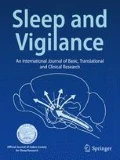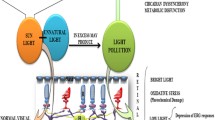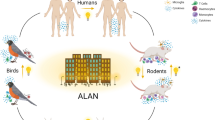Abstract
Light pollution is a rising global concern which impacts not only ecology but has a wide range of deleterious effect on human health as well. Artificial light at night (ALAN) has been linked to increased risk of cancers including shift workers at night. Apart from cancer, ALAN has been the cause of disrupted circadian rhythm, disturbances in sleep pattern, obesity, stress, alterations in the rhythmicity of gut microbiota and free radical damage. Melatonin, a wonder molecule dubbed as the hormone of darkness, appears to be involved in a plethora of physiological processes and abnormalities including control of sleep, circadian rhythms, retinal physiology, seasonal reproductive cycles, cancer development and growth, immune activity, antioxidation and free radical scavenging. Potential detrimental effects of artificial light are not known to all, hidden perils of light are yet to be brought in full public knowledge so that nighttime light can be dealt with effectively.
Similar content being viewed by others
References
Chepesiuk R. Missing the dark: health effects of light pollution. Environ Health Perspect. 2009. https://doi.org/10.1289/ehp.117-a20.
Portree DS. Flagstaff’s battle for dark skies. Los Angeles: The Griffith Observer; 2002.
Ward EM, Germolec D, Kogevinas M, McCormick D, Vermeulen R, Anisimov VN, Aronson KJ, Bhatti P, Cocco P, Costa G, Dorman DC. Carcinogenicity of night shift work. Lancet Oncol. 2019;20(8):1058–9.
Al-Naggar RA, Anil S. Artificial light at night and cancer: a global study. Asian Pac J Cancer Prev APJCP. 2016;17(10):4661.
Garcia-Saenz A, Sánchez de Miguel A, Espinosa A, Valentin A, Aragonés N, Llorca J, Amiano P, Martín Sánchez V, Guevara M, Capelo R, Tardón A. Evaluating the association between artificial light-at-night exposure and breast and prostate cancer risk in Spain (MCC-Spain study). Environ Health Perspect. 2018;126(4):047011.
Gaston KJ, Davies TW, Bennie J, Hopkins J. REVIEW: reducing the ecological consequences of night-time light pollution: options and developments. J Appl Ecol. 2012;49(6):1256–66.
Carta M, Preti A, Akiskal H. Coping with the new era: noise and light pollution, hyperactivity and steroid hormones. Towards an evolutionary view of bipolar disorders. Clin Pract Epidemiol Mental Health. 2018;14(1):33–6.
Min JY, Min KB. Outdoor artificial nighttime light and use of hypnotic medications in older adults: a population-based cohort study. J Clin Sleep Med. 2018;14(11):1903–10.
Koo Y, Choi J, Jung K. Sleep disturbances and their relationship with excessive exposure to light at night: the Korean genome and epidemiology study. Sleep Med. 2013;14:e29-30.
Koo YS, Song JY, Joo EY, Lee HJ, Lee E, Lee SK, Jung KY. Outdoor artificial light at night, obesity, and sleep health: Cross-sectional analysis in the KoGES study. Chronobiol Int. 2016;33(3):301–14.
Ohayon MM, Milesi C. Artificial outdoor nighttime lights associate with altered sleep behaviour in the American general population. Sleep. 2016;39(6):1311–20.
Keshet-Sitton A, Or-Chen K, Huber E, Haim A. Illuminating a risk for breast cancer: a preliminary ecological study on the association between streetlight and breast cancer. Integr Cancer Ther. 2017;16(4):451–63.
James P, Bertrand KA, Hart JE, Schernhammer ES, Tamimi RM, Laden F. Outdoor light at night and breast cancer incidence in the Nurses’ Health Study II. Environ Health Perspect. 2017;125(8):087010.
Kloog I, Stevens RG, Haim A, Portnov BA. Nighttime light level co-distributes with breast cancer incidence worldwide. Cancer Causes Control. 2010;21(12):2059–68.
Lystrup DE. The dark side of the light: rachel carson, light pollution, and the case for federal regulation. Jurimetrics. 2016;57:505.
Mizon B. Book review: light pollution: responses and remedies/Springer, 2001/2002. Astron Geophys. 2002;43(1):31.
Motta M. US physicians join light-pollution fight. Sky & Telesc, http://www.skyandtelescope.com/news/48814012.HTML. Accessed 10 Sep 2010.
Walker CE, Pompea SM, Iya Dark Skies Awareness Working Group. Dark skies awareness cornerstone project for the international year of astronomy. AGU fall meeting abstracts. 2010.
Alcock C. The dark halo of the Milky Way. Science. 2000;287(5450):74–9.
Posudin Y. Methods of measuring environmental parameters. Hoboken: Wiley; 2014.
Zee PC, Attarian H, Videnovic A. Circadian rhythm abnormalities. Continuum. 2013;19(1 Sleep Disorders):132–47.
Fonken LK, Nelson RJ. The effects of light at night on circadian clocks and metabolism. Endocr Rev. 2014;35(4):648–70.
Arendt J. Melatonin and human rhythms. Chronoiol Int. 2006;23:21–37.
Reiter RJ, editor. Melatonin. Endocrine 2005;27: 87–212.
Blask DE, Sauer LA, Dauchy RT. Melatonin as a chronobiotic/anticancer agent: cellular, biochemical, and molecular mechanisms of action and their implications for circadian-based cancer therapy. Curr Top Med Chem. 2002;2:113–32.
Blask DE, Dauchy RT, Sauer LA. Putting cancer to sleep at night—the neuroendocrine/circadian melatonin signal. Endocrine. 2005;27:179–88.
Stevens RG, London SJ. Breast cancer. In: Stevens RG, editor. The melatonin hypothesis—breast cancer and the use of electric power. Columbus: Battelle Press; 1997. p. 9–24.
Stevens RG, Rea MS. Light in the built-in environment: potential role of circadian disruption in endocrine disruption and breast cancer. Cancer Causes Control. 2001;12:279–87.
Stevens RG. Electric power use and breast cancer: a hypothesis. Am J Epidemiol. 1987;125:556–61.
Blask DE, Brainard GC, Dauchy RT, Hanifin JP, Davidson LK, Krause JA, et al. Melatonin-depleted blood from premenopausal women exposed to light at night stimulates the growth of human breast cancer xenografts in nude rats. Cancer Res. 2005;65:11174–84.
Kloog I, Haim A, Stevens RG, Barchana M, Portnov BA. Light at night codistributes with incident breast but not lung cancer in the female population of Israel. Chronobiol Int. 2008;25:65–81.
Davis S, Mirick DK, Stevens RG. Night shift work, light at night, and risk of breast cancer. J. Natl. Cancer Inst. 2001;93(20):1557–62.
Kim KY, Lee E, Kim YJ, Kim J. The association between artificial light at night and prostate cancer in Gwangju City and South Jeolla Province of South Korea. Chronobiol. Int. 2017;34(2):203–11.
Garcia-Saenz A, de Miguel AS, Espinosa A, Costas L, Aragonés N, Tonne C, Moreno V, Pérez-Gómez B, Valentin A, Pollán M, Castaño-Vinyals G. Association between outdoor light-at-night exposure and colorectal cancer in Spain. Epidemiology. 2020;31(5):718–27.
Liu R, Fu A, Hoffman AE, Zheng T, Zhu Y. Melatonin enhances DNA repair capacity possibly by affecting genes involved in DNA damage responsive pathways. BMC Cell Biol. 2013;14(1):1–8.
Johnson CH. Circadian clocks and cell division: what’s the pacemaker? Cell Cycle. 2010;9(19):3864–73.
Nagoshi E, Saini C, Bauer C, Laroche T, Naef F, Schibler U. Circadian gene expression in individual fibroblasts: cell-autonomous and self-sustained oscillators pass time to daughter cells. Cell. 2004;119:693–705.
Welsh DK, Yoo SH, Liu AC, Takahashi JS, Kay SA. Bioluminescence imaging of individual fibroblasts reveals persistent, independently phased circadian rhythms of clock gene expression. Curr Biol. 2004;14:2289–95.
Gréchez-Cassiau A, Rayet B, Guillaumond F, Teboul M, Delaunay F. The circadian clock component BMAL1 is a critical regulator of p21WAF1/CIP1 expression and hepatocyte proliferation. J Biol Chem. 2008;283:4535–42.
Kowalska E, Ripperger JA, Hoegger DC, Bruegger P, Buch T, Birchler T, et al. NONO couples the circadian clock to the cell cycle. Proc Natl Acad Sci USA. 2013;110:1592–9.
Matsuo T, Yamaguchi S, Mitsui S, Emi A, Shimoda F, Okamura H. The control mechanism of the circadian clock for timing of cell division in vivo. Science. 2003;302:255–9.
Akerstedt T, Wright KP. Jr Sleep loss and fatigue in shift work and shift work disorder. Sleep Med Clin. 2009;4(2):257–71.
Short MA, Agostini A, Lushington K, Dorrian J. A systematic review of the sleep, sleepiness, and performance implications of limited wake shift work schedules. Scand J Work Environ Health. 2015;41(5):425–40.
Obayashi K, Saeki K, Kurumatani N. Association between light exposure at night and insomnia in the general elderly population: the HEIJO-KYO cohort. Chronobiol Int. 2014;31(9):976–82.
Raap T, Pinxten R, Eens M. Artificial light at night disrupts sleep in female great tits (Parus major) during the nestling period and is followed by a sleep rebound. Environ Pollut. 2016;215:125–34.
Stenvers DJ, van Dorp R, Foppen E, et al. Dim light at night disturbs the daily sleep-wake cycle in the rat. Sci Rep. 2016;6:35662.
Fritschi L, Glass DC, Heyworth JS, Aronson K, Girschik J, Boyle T, et al. Hypotheses for mechanisms linking shift work and cancer. Med Hypotheses. 2011;77(3):430–6.
Cos S, Gonzalez A, Martinez-Campa C, Mediavilla MD, Alonso-Gonzalez C, Sanchez-Barcelo EJ. Melatonin as a selective estrogen enzyme modulator. Curr Cancer Drug Targets. 2008;8(8):691–702.
Shang Y. Hormones and cancer. Cell Res. 2007;17(4):277–9.
Derwahl M, Nicula D. Estrogen and its role in thyroid cancer. Endocr Relat Cancer. 2014;21(5):T273–83.
Yang W, Shi Y, Ke X, Sun H, Guo J, Wang X. Long-term sleep habits and the risk of breast cancer among Chinese women: a case-control study. Eur J Cancer Prev. 2018;28(4):323–9.
Moreno-Smith M, Lutgendorf SK, Sood AK. Impact of stress on cancer metastasis. Future Oncol. 2010;6(12):1863–81.
Garssen B. Psychological factors and cancer development: evidence after 30 years of research. Clin Psychol Rev. 2004;24:315–38.
Chida Y, Hamer M, Wardle J, Steptoe A. Do stress-related psychosocial factors contribute to cancer incidence and survival? Nat Clin Pract Oncol. 2008;5:466–75.
Thaker PH, Han LY, Kamat AA, Arevalo JM, Takahashi R, Lu C, Jennings NB, Armaiz-Pena G, Bankson JA, Ravoori M, Merritt WM, Lin YG, Mangala LS, Kim TJ, Coleman RL, Landen CN, Li Y, Felix E, Sanguino AM, Newman RA, Lloyd M, Gershenson DM, Kundra V, Lopez-Berestein G, Lutgendorf SK, Cole SW, Sood AK. Chronic stress promotes tumour growth and angiogenesis in a mouse model of ovarian carcinoma. Nat Med. 2006;12:939–44.
Sood AK, Bhatty R, Kamat AA, Landen CN, Han L, Thaker PH, Li Y, Gershenson DM, Lutgendorf S, Cole SW. Stress hormone-mediated invasion of ovarian cancer cells. Clin Cancer Res. 2006;12:369–75.
Sephton S, Spiegel D. Circadian disruption in cancer: a neuroendocrine-immune pathway from stress to disease? Brain Behav Immun. 2003;17:321–8.
Reiche EM, Nunes SO, Morimoto HK. Stress, depression, the immune system and cancer. Lancet Oncol. 2004;5:617–25.
Padgett DA, Glaser R. How stress influences the immune response. Trends Immunol. 2003;24:444–8.
Segerstrom SC, Miller GE. Psychological stress and the human immune system: a meta-analytic study of 30 years of inquiry. Psychol Bull. 2004;130:601–30.
Lutgendorf SK, Cole S, Costanzo E, Bradley S, Coffin J, Jabbari S, Rainwater K, Ritchie JM, Yang M, Sood AK. Stress-related mediators stimulate vascular endothelial growth factor secretion by two ovarian cancer cell lines. Clin Cancer Res. 2003;9:4514–21.
Maudsley S, Pierce KL, Zamah AM, Miller WE, Ahn S, Daaka Y, Lefkowitz RJ, Luttrell LM. The β2-Adrenergic receptor mediates extracellular signal-regulated kinase activation via an assembly of a multi-receptor complex with the epidermal growth factor receptor. J Biol Chem. 2000;275:9560–72.
Drube S, Stirnweiss J, Valkova C, Liebmann C. Ligand-independent and EGF receptor-supported transactivation: lessons from beta2-adrenergic receptor signalling. Cell Signal. 2006;18:1633–46.
Chen Y, Tan F, Wei L, Li X, Lyu Z, Feng X, Wen Y, Guo L, He J, Dai M, Li N. Sleep duration and the risk of cancer: a systematic review and meta-analysis including dose–response relationship. BMC Cancer. 2018;18(1):1149.
Schernhammer ES, Laden F, Speizer FE, Willett WC, Hunter DJ, Kawachi I, Fuchs CS, Colditz GA. Night-shift work and risk of colorectal cancer in the nurses’ health study. J. Natl. Cancer Inst. 2003;95(11):825–8.
Sauer LA, Dauchy RT, Blask DE. Polyunsaturated fatty acids, melatonin, and cancer prevention. Biochem Pharmacol. 2001;61(12):1455–62.
Yang W, Tang K, Wang Y, Zhang Y, Zan L. Melatonin promotes triacylglycerol accumulation via MT2 receptor during differentiation in bovine intramuscular preadipocytes. Sci Rep. 2017;7(1):1–2.
De La Torre A, Debiton E, Durand D, Chardigny JM, Berdeaux O, Loreau O, Barthomeuf C, Bauchart D, Gruffat D. Conjugated linoleic acid isomers and their conjugated derivatives inhibit the growth of human cancer cell lines. Anticancer Res. 2005;25(6B):3943–9.
Lennernas M, Akerstedt T, Hambraeus L. Nocturnal eating and serum cholesterol of three-shift workers. Scand J Work Environ Health. 1994;20:401–6.
Holmback U, Forslund A, Forslund J, Hambraeus L, Lenneras M, Lowden A, et al. Metabolic responses to nocturnal eating in men are affected by sources of dietary energy. J Nutr. 2002;132:1892–9.
Hansen J. Increased breast cancer among women who work predominantly at night. Epidemiology. 2002;12:74–7.
Davis S, Mirick DK, Stevens RG. Night shift work, a light at night, and risk of breast cancer. J Natl Cancer Inst. 2001;93:1557–62.
Schernhammer ES, Laden F, Speizer FE, Willet WC, Hunter DJ, Kawachi I, et al. Rotating night shifts and risk of breast cancer in women participating in the nurses’ health study. J Natl Cancer Inst. 2001;93:1563–8.
Schernhammer ES, Kroenke CH, Laden F, Hankinson SE. Night work and risk of breast cancer. Epidemiology. 2006;17:108–11.
Diaz HR, Wang S, Anuar F, Qian Y, Bjorkholm B, Samuelsson A, Hibberd ML, Forssberg H, Pettersson S. Normal gut microbiota modulates brain development and behaviour. Proc Natl Acad Sci USA. 2011;108:3047–52.
Liang X, Bushman FD, FitzGerald GA. Rhythmicity of the intestinal microbiota is regulated by gender and the host circadian clock. Proc Natl Acad Sci. 2015;112(33):10479–84.
Pedram P, Wadden D, Amini P, Gulliver W, Randell E, Cahill F, Vasdev S, Goodridge A, Carter JC, Zhai G, Ji Y, Sun G. Food addiction: its prevalence and significant association with obesity in the general population. PLoS ONE. 2013;8:e74832.
Tolhurst G, Heffron H, Lam YS, Parker HE, Habib AM, Diakogiannaki E, Cameron J, Grosse J, Reimann F, Gribble FM. Short-chain fatty acids stimulate glucagon-like peptide-1 secretion via the G-protein-coupled receptor FFAR2. Diabetes. 2012;61:364–71.
Everard A, Lazarevic V, Derrien M, Girard M, Muccioli GG, Neyrinck AM, Possemiers S, Van Holle A, Francois P, de Vos WM, Delzenne NM, Schrenzel J, Cani PD. Responses of gut microbiota and glucose and lipid metabolism to prebiotics in genetic obese and diet-induced leptin-resistant mice. Diabetes. 2011;60:2775–86.
Deaver JA, Eum SY, Toborek M. Circadian disruption changes gut microbiome taxa and functional gene composition. Front. Microbiol. 2018;9:737.
Fahimipour AK, Maamar SB, McFarland AG, Blaustein RA, Chen J, Glawe AJ, Kline J, Green JL, Halden RU, Van Den Wymelenberg K, Huttenhower C. Antimicrobial chemicals associate with microbial function and antibiotic resistance indoors. Msystems. 2018;3(6).
Wu G, Tang W, He Y, Hu J, Gong S, He Z, Wei G, Lv L, Jiang Y, Zhou H, Chen P. Light exposure influences the diurnal oscillation of gut microbiota in mice. Biochem. Biophys. Res. Commun. 2018;501(1):16–23
Parkar SG, Kalsbeek A, Cheeseman JF. Potential role for the gut microbiota in modulating host circadian rhythms and metabolic health. Microorganisms. 2019;7(2):41.
Klimina KM, Batotsyrenova EG, Yunes RA, Gilyaeva EH, Poluektova EU, Kostrova TA, Kudryavtseva AV, Odorskaya MV, Kashuro VA, Kasianov AS, Ivanov MB. The effects of desynchronosis on the gut microbiota composition and physiological parameters of rats. BMC Microbiol. 2019;19(1):160.
Reiter RJ. Mechanisms of cancer inhibition by melatonin. J Pineal Res. 2004;37:213–4.
WHO. Obesity: preventing and managing the global epidemic. World Health Organization Technical Report Series No. 894. Geneva; 2000.
Ng M, Fleming T, Robinson M, Thomson B, Graetz N, Margono C, et al. Global, regional, and national prevalence of overweight and obesity in children and adults during 1980–2013: A systematic analysis for the Global Burden of Disease Study 2013. Lancet. 2014;384(9945):766–81.
Rybnikova NA, Haim A, Portnov BA. Does artificial light-at-night exposure contribute to the worldwide obesity pandemic? Int J Obes. 2016;40(5):815–23.
Bell J, Zimmerman F. Shortened nighttime sleep duration in early life and subsequent childhood obesity. Arch Pediatr Adolesc Med. 2010;164(11):840–5.
Scharf R, DeBoer M. Sleep timing and longitudinal weight gain in 4- and 5-year-old children. Pediatr Obes. 2015;10(2):141–8.
Golley RK, Maher CA, Matricciani L, Olds TS. Sleep duration or bedtime? Exploring the association between sleep timing behaviour, diet and BMI in children and adolescents. Int J Obes. 2013;37(4):546–51.
DiBaise JK, Zhang H, Crowell MD, Krajmalnik-Brown R, Decker GA, Rittmann BE. Gut microbiota and its possible relationship with obesity. Mayo Clin Proc. 2008;83(4):460–9.
Park YM, White AJ, Jackson CL, Weinberg CR, Sandler DP. Association of exposure to artificial light at night while sleeping with the risk of obesity in women. JAMA Internal Med. 2019;179(8):1061–71.
Gallagher EJ, LeRoith D. Obesity and diabetes: the increased risk of cancer and cancer-related mortality. Physiol Rev. 2015;95(3):727–48.
Seo BR, Bhardwaj P, Choi S. Obesity-dependent changes in interstitial ECM mechanics promote breast tumorigenesis. Sci Transl Med. 2015;7(301):301ra130.
Roberts DL, Dive C, Renehan AG. Biological mechanisms linking obesity and cancer risk: new perspectives. Annu Rev Med. 2010;61:301–16.
Leon-Blanco MM, Guerrero JM, Reiter RJ, Calvo JR, Pozo D. Melatonin inhibits telomerase activity in the MCF-7 tumour cell line both in vivo and in vitro. J Pineal Res. 2003;35(3):204–11.
Hao J, Fan W, Li Y, Tang R, Tian C, Yang Q, Zhu T, Diao C, Hu S, Chen M, Guo P. Melatonin synergizes BRAF-targeting agent vemurafenib in melanoma treatment by inhibiting iNOS/hTERT signalling and cancer stem cell traits. J Exp Clin Cancer Res. 2019;38(1):48.
Wang W, Luo HS, Yu BP. Expression of NF-κB and human telomerase reverse transcriptase in gastric cancer and precancerous lesions. World J Gastroenterol. 2004;10(2):177.
Larin AA, Karpova SA, Kim Y, McCarley RW, Basheer R, Kalinchuk A. Relationship between adenosine and glutamate during sleep deprivation. In: Sleep 2017 Apr 1 (vol. 40, pp. a47-a48). Journals Dept, 2001 Evans RD, Cary, NC 27513 USA: Oxford Univ Press Inc.
Oikonomou G, Prober DA. Attacking sleep from a new angle: contributions from zebrafish. Curr Opin Neurobiol. 2017;44:80–8.
Oktyabrskiy VP. A new opinion of the greenhouse effect. St Petersburg Polytech Univ J Phys Math. 2016;2(2):124–6.
Karu TI. Mitochondrial signaling in mammalian cells activated by red and near-IR radiation. Photochem Photobiol. 2008;84(5):1091–9.
Tähkämö L, Halonen L. Life cycle assessment of road lighting luminaires–comparison of light-emitting diode and high-pressure sodium technologies. J Clean Prod. 2015;93:234–42.
Acknowledgements
To the library for the plagiarism check.
Funding
Nil.
Author information
Authors and Affiliations
Contributions
SwR wrote first draft of manuscript. MN managed literature search and did final editing of manuscript. KM helped with literature searches. SaR critically appraised the study. All authors read and approved the final manuscript.
Corresponding author
Ethics declarations
Conflict of interest
The author(s) declare that they have no competing interests.
Additional information
Publisher's Note
Springer Nature remains neutral with regard to jurisdictional claims in published maps and institutional affiliations.
Rights and permissions
About this article
Cite this article
Rajput, S., Naithani, M., Meena, K. et al. Light pollution: hidden perils in light and links to cancer. Sleep Vigilance 5, 5–16 (2021). https://doi.org/10.1007/s41782-020-00123-3
Received:
Accepted:
Published:
Issue Date:
DOI: https://doi.org/10.1007/s41782-020-00123-3




